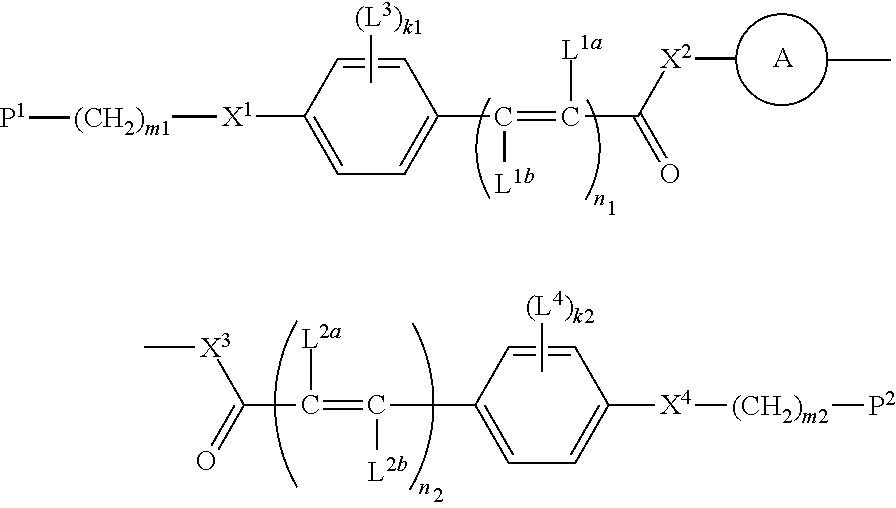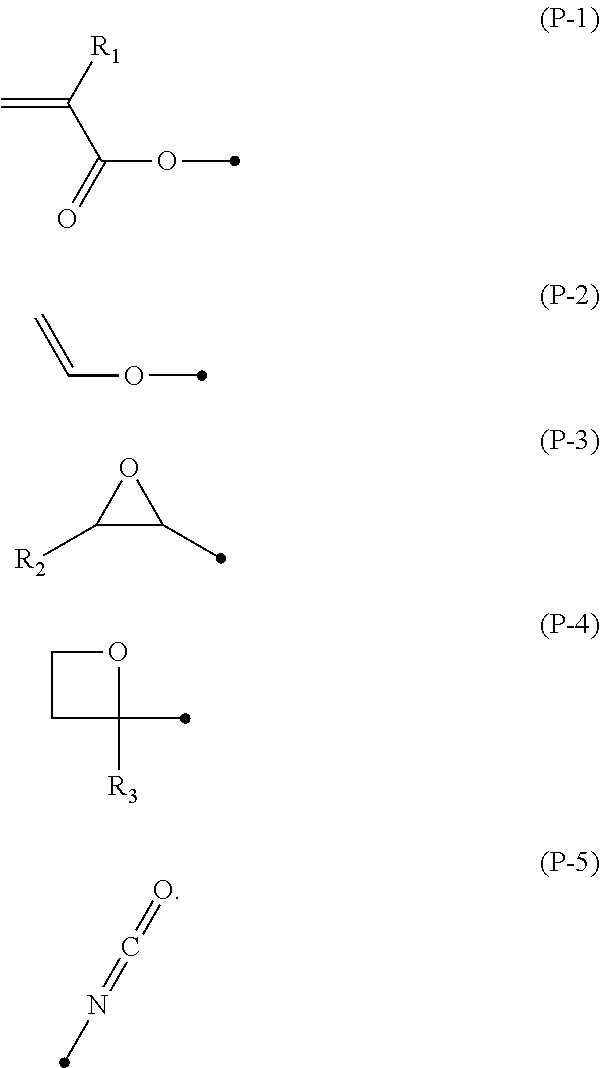Compound, polymerizable liquid crystal composition, polymer and film
a liquid crystal composition and polymer technology, applied in the field of polymerizable liquid crystal compositions, polymer and film, can solve the problems of poor film-forming properties, poor optical characteristics of cured films, and insufficient polymerizable liquid crystal compounds, etc., to achieve good compatibility and high n
- Summary
- Abstract
- Description
- Claims
- Application Information
AI Technical Summary
Benefits of technology
Problems solved by technology
Method used
Image
Examples
example 1
Synthetic Example of Compound (I-1)
[0130]Compound (I-1) was prepared according to the following scheme.
[0131]
Synthesis of Intermediate (A):
[0132]Intermediate (A) was prepared according to the process described in Japanese Patent No. 4355406, p. 23, [0109]-[0110]. The determination of the obtained compound was performed by measurement of 1H-NMR spectra.
[0133]1H-NMR (Solvent: CDCl3, Standard: tetramethyl silane) δ (ppm): 1.85-1.95 (4 H, m), 4.03(2 H, t), 4.25(2 H, t), 5.82(1 H, d), 6.12(1 H, dd), 6.31(1H, d), 6.41(1 H, d), 6.91(2 H, d), 7.51(2 H, d), 7.73(1 H, d).
Synthesis of Compound (I-1):
[0134]Intermediate (A) (1.99 g) and tetrahydrofuran (THF) (10 mL) were put into a three-necked flask, and cooled to 0 degree Celsius by using a cooling medium of ice / methanol. After that, the mixture was added dropwise with mesylchloride (MsCl) (0.53 mL), and subsequently added with N,N-diisopropyl ethylamine (1.33 mL). After being stirred at 0 degree Celsius for 30 minutes, the mixture was added d...
example 2
Synthetic Example of Compound (I-2)
[0137]Compound (I-2) was prepared according to the following scheme.
[0138]
Synthesis of Intermediates (A) and (B):
[0139]Intermediate (A) was prepared in the same manner as described above.
[0140]Intermediate (B) was prepared in the same manner as described in Japanese Patent No. 4355406. p. 23, [0109]-[0110], except that vanillin was used in place of 4-hydroxy benzaldehyde.
Synthesis of Compound (I-2):
[0141]Compound (I-2) was prepared in the same manner as Compound (I-1) by using Intermediates (A) and (B). The determination of the obtained compound was performed by measurement of 1H-NMR spectra.
[0142]1H-NMR (Solvent: CDCl3, Standard: tetramethyl silane)δ(ppm): 1.85-1.95 (4 H, m), 3.90(3 H s), 4.10(2 H, t), 4.25(2 H, t), 5.82(1 H, d), 6.12(1 H, dd), 6.31(1 H, d), 6.41(1 H, d), 6.91(2 H, d), 7.51(2 H, d), 7.73(1 H, d).
example 3
Synthetic Example of Compound (I-3)
[0143]Compound (I-3) was prepared according to the following scheme in the same manner as Example 1, except that Intermediate (B) was used in place of Intermediate (A).
[0144]
[0145]The determination of the obtained compound was performed by measurement of 1H-NMR spectra.
[0146]1H-NMR (Solvent: CDCl3, Standard: tetramethyl silane)δ(ppm): 1.85-1.95 (8 H, m), 3.90(6 H, s), 4.10(4 H, t), 4.25(4 H, t), 5.82(2 H, d), 6.12(2 H, dd), 6.31(2 H, d), 6.50(1 H, d), 6.91(2 H, d), 7.10-7.40(10 H, m), 7.58(2 H, d), 7.83(2 H, d), 8.11(1 H, d).
PUM
| Property | Measurement | Unit |
|---|---|---|
| tilt angle | aaaaa | aaaaa |
| temperature | aaaaa | aaaaa |
| temperature | aaaaa | aaaaa |
Abstract
Description
Claims
Application Information
 Login to View More
Login to View More - R&D
- Intellectual Property
- Life Sciences
- Materials
- Tech Scout
- Unparalleled Data Quality
- Higher Quality Content
- 60% Fewer Hallucinations
Browse by: Latest US Patents, China's latest patents, Technical Efficacy Thesaurus, Application Domain, Technology Topic, Popular Technical Reports.
© 2025 PatSnap. All rights reserved.Legal|Privacy policy|Modern Slavery Act Transparency Statement|Sitemap|About US| Contact US: help@patsnap.com



